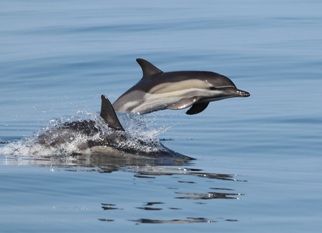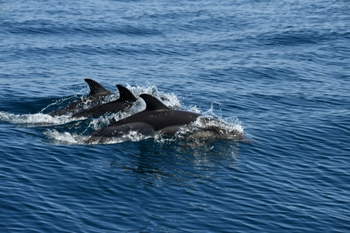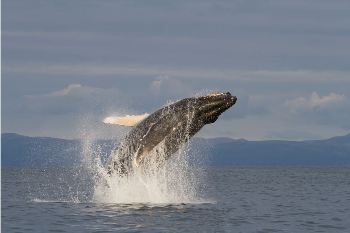Please activate JavaScript in your browser to use all interface options.
July 23 - World Whale and Dolphin Day
23 July 2021
World Whale and Dolphin Day is celebrated annually on 23 July. The environmental day aims to raise awareness of the need to conserve and protect whales, cetaceans and other marine mammals.
Rosneft, together with the Shirshov Institute of Oceanology of the Russian Academy of Sciences, has been implementing a comprehensive project to study and monitor Black Sea dolphins since 2018.
Marine mammals in the Black Sea fauna are represented by three species of dolphin: the bottlenose dolphin, the common dolphin and the harbour porpoise (Azov dolphin). All of these mammal species are registered in the International Red List and the Red List of the International Union for Conservation of Nature.
 The research took place in the north-eastern part of the Black Sea in 2018-2020 and included offshore and onshore observations, an aerial survey of the waters and laboratory and analytical works. Scientists observed the behaviour of the mammals, took photographs to identify the animals and make a photographic catalogue. Moreover, acoustic studies have been carried out to determine the number of animals, as each dolphin has its own distinctive “voice”. A considerable amount of research material was collected during the fieldwork, thanks to the use of special equipment, and an extensive database of dolphin “voices” was created.
The research took place in the north-eastern part of the Black Sea in 2018-2020 and included offshore and onshore observations, an aerial survey of the waters and laboratory and analytical works. Scientists observed the behaviour of the mammals, took photographs to identify the animals and make a photographic catalogue. Moreover, acoustic studies have been carried out to determine the number of animals, as each dolphin has its own distinctive “voice”. A considerable amount of research material was collected during the fieldwork, thanks to the use of special equipment, and an extensive database of dolphin “voices” was created.
The results of the three-year study provide up-to-date, relevant data on the numbers, occurrence and preferred habitats of Black Sea dolphins and their seasonal dispersal patterns. A more detailed description of the research can be found on our website.
An aerial cetacean survey method using streaming interval photography has also been developed and adapted for the Black Sea region. The qualitative and quantitative description of the sound signals of the Black Sea dolphins was introduced as a necessary basis for future acoustic monitoring. Extensive toxicological studies have been carried out, providing an initial health assessment of Black Sea cetaceans.
 Guidelines for the study and conservation of Black Sea cetaceans have been prepared on the basis of the findings. A key component of these guidelines is further monitoring of Black Sea cetacean populations, using the data collected in 2018-2020 as a baseline.
Guidelines for the study and conservation of Black Sea cetaceans have been prepared on the basis of the findings. A key component of these guidelines is further monitoring of Black Sea cetacean populations, using the data collected in 2018-2020 as a baseline.
As part of the Sakhalin-1 project, Rosneft, together with Exxon Neftegas Limited, is involved in the conservation of the Okhotsk-Korean gray whale population at offshore northeast Sakhalin Island.
The annual monitoring programme for gray whales includes population counts, behavioural and prey observations, photo-identification studies, and acoustic monitoring.
The populations of gray and bowhead whales in the Sea of Okhotsk were included in the list of rare and endangered wildlife species requiring priority recovery and reintroduction measures by order of the Russian Ministry of Natural Resources and Environment in 2019.
The Okhotsk Sea gray whale population is registered in the Red Book of the Russian Federation in 2020 in the categories Endangered and Critically Endangered, by the 1st Conservation Status.
Note for Editors:
Environment protection is an integral part of the Rosneft’s corporate culture and one of the key operation principles. The Company has been a participant in the UN Global Compact for more than 10 years. Rosneft reaffirmed its commitment to 17 UN Sustainable Development Goals in 2018, including Goals 6 Clean Water and Sanitation, and 14 Life Below Water. The Company has developed an Environmental Development Concept to 2035, which includes approaches to the rational use of water resources and measures to conserve, protect and replenish aquatic biological resources, in support of these goals.
Rosneft
Information Division
July 23, 2021

-315xx70.png)

